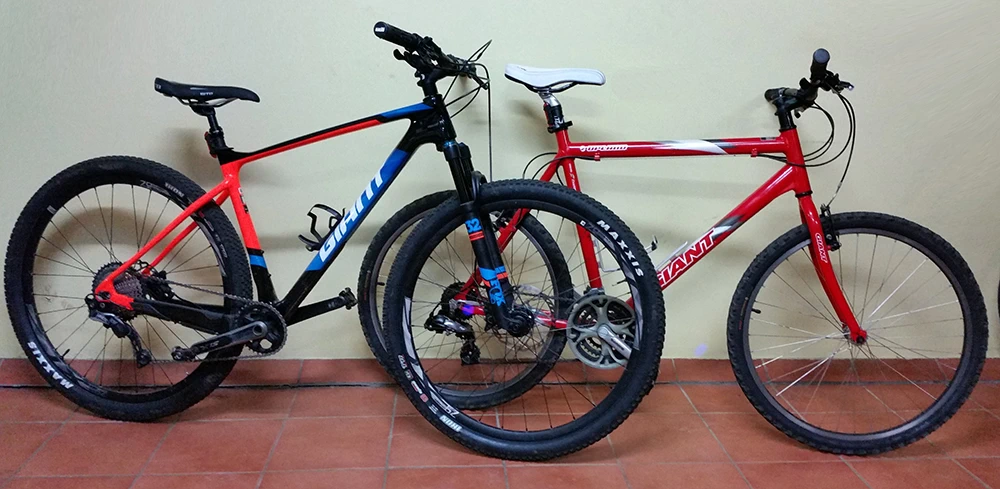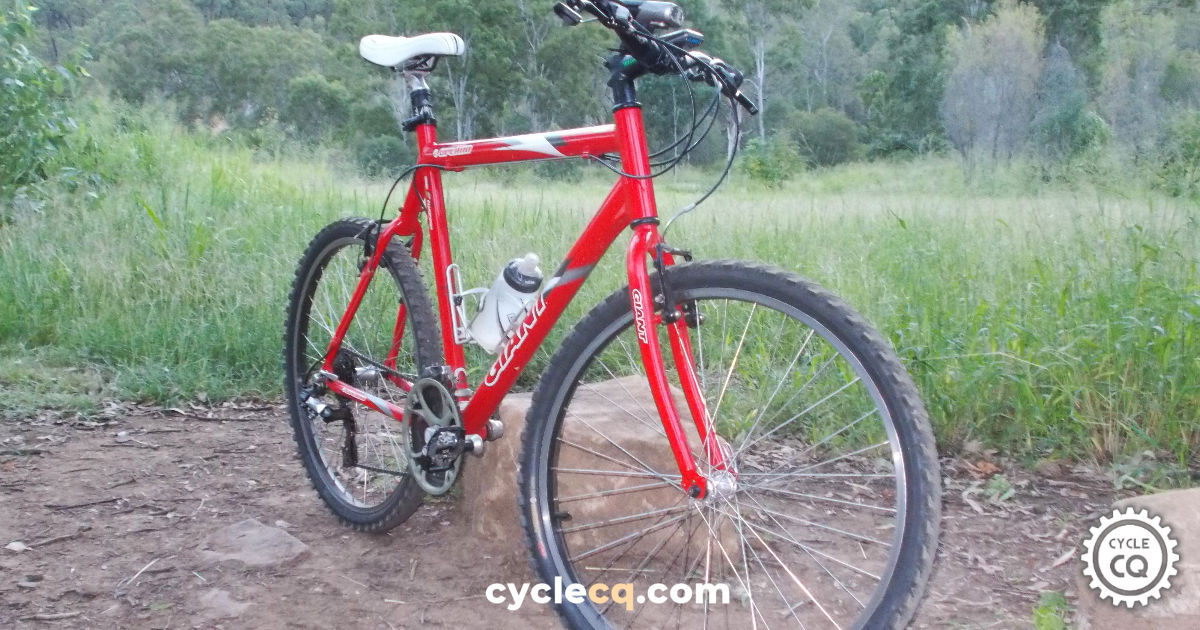I present this argument to every mountain biker, whether experienced, recreational, or novice: You need a retro fully-rigid MTB in your life.
OK you cynics, stop laughing.
A fully-rigid will make you a better rider
Nowadays, even if you buy a cheap new bike from Anaconda, it comes with a fair bit of kit - not great quality kit but certainly stuff designed to make the ride easier for beginners. We get disc brakes to pull us up quicker, adjustable forks to fine-tune the steering, and if we go the dual suspension route, a rear shock to dampen the bumps.
However, the downside of all these standard features is that a rider - especially new riders who've known nothing else - don't learn the true skills of riding. Nor do they experience the subsequent joy of transferring those skills when they eventually upgrade their bike.
If you watch any mountain biking video about improving your skills, without actually stating so, they're all about compensating for the bad habits we've picked up since the advent of dual suspension bikes.
So many tips are aimed at correcting poor technique, e.g. sitting too much instead of standing, holding the handlebars too tight, bashing through obstacles instead of finding the best line, and not using the bike's most effective suspension component - your legs. With a fully-rigid bike, you have no choice but to ride the thing correctly. You learn the skills automatically.
Without a rear shock, you have no choice but to ride out of the saddle through rough sections, while without a spongy fork, you have to adopt a looser grip on the handlebars or else you'll jar your wrists. And without any suspension at all, you naturally develop the use of your legs as springs.
You stop riding ON the bike as though it's a sofa and instead you ride the bike like you're in charge. It's merely an extension of you.
A fully-rigid is also a great training tool for rock gardens and roots. Without suspension, you're force to search for the smoothest line and to lean back - again getting out of your seat - to lift your wheel over an obstacle.
Then there's braking. When you hear someone on their fancy dual-suspension rig skidding through a switchback, they've braked too hard and too late, relying on their super efficient discs to lock up quickly. Their technique is poor.
When you're on a fully-rigid retro with rudimentary brakes and no suspension to absorb the bumps, you learn to brake wisely and in advance. You can still ride that corner fast - you simply ride it smarter.
Where the fully-rigid excels
It all sounds like hard work, right? But it isn't. Sure there's a bit of pain when learning new skills but I always end my rigid session with fun.
The local First Turkey MTB Park here in Rockhampton features a couple of blue trails where the fully-rigid shines and I always have a wind-down session there. It starts with a 7 minute climb to the Lighthouse hub via Wild Pig, a winding green trail with tight switchbacks and lazy straights on hard packed clay. The rigid glides up that track.
Once up at the hub, there's a choice of two flow trails, Whip Snake or Cactus, both hard packed with rollers and jumps and high banked berms. The fully-rigid loves this kind of stuff and the descent is my treat for all the suffering I've endured on tougher trails.
When you find that perfect downhill line on that perfect flow trail, just release the brakes and go. Those narrow tyres on hard packed earth, with next to zero rolling resistance and no suspension to sap your speed - It's pure gravity, a mad adrenaline rush like roller blades on concrete, just you and your bike rocketing downhill smooth as silk. No other type of bike offers that.
Fully-rigid vs hard-tail
Fine, I hear you say, but why not just lock out the fork on my hard-tail to achieve the same effect? Well yes, you can do that but it isn't really the same.
For one thing, full lockout isn't actually full lockout. On a high end Fox Factory for example, it's about 95% lockout. There's still a fraction of give to prevent damage to the fork.
Also, you can't compare the experience of riding a 10 kg carbon 29er running disc brakes and 2.4 wide tyres with a heavy 26er running rim brakes and 1.95s. The two rigs don't feel remotely alike.
Finally there's the mental aspect and this is probably the most important observation. On my carbon hard-tail for example, I know that at any point I can simply flick the switch on my plush Fox 32s to relieve my arm-pump. Given that option after an hour's hard riding, I certainly would. In fact, I wouldn't even lock out the forks in the first place unless I'm on a stretch of tarmac.
With the fully-rigid bike, I don't have that luxury. As soon as I'm clipped in, this awareness alters the way I ride as well as my mindset.
"Suck it up Princess, adjust your grip and keep going."
It teaches you discipline and endurance and also makes you ride adaptively and dare I say, aggressively. These are ideal traits for an XC racer.

So, how do you get your hands on a fully-rigid MTB? Well, here's the bad news. Except for a few boutique offerings from manufacturers like Niner and Wilier, none of the mainstream brands make fully-rigid bikes anymore. In Australia at least, they're a thing of a bygone age.
The usual online marketplaces like eBay, Gumtree, or Facebook sometimes yields a few secondhand rigs. Alternatively you can buy a rigid fork for about a hundred bucks to fit your existing hard-tail. The latter isn't quite the same as finding a factory retro but it's close.
If you don't mind spending a bit more money, another option worth pursuing is a cyclo-cross bike. They're usually fully-rigid and the entry level models are cheap as chips. It's then just a matter of swapping the drop bars for flats.
My own observations
There's something in our DNA that draws us towards the latest two-wheeled toys like a junkie craves drugs, yet most of us aren't world champions. We might compete at local or state level, or maybe we don't race at all.
As for myself, I'm not the best rider in the world, far from it. I'd call myself intermediate. I'm 52, take part in a few races, and try to stay in the top 10% on my chosen Strava segments. I'm the average Joe you meet out in the bike park and I guess that's the point of this article.
Like many cycling addicts, I've got a stable of bikes to satisfy my various cravings. There's a carbon Giant hard-tail for XC, a Scott Genius for enduro, a Scott fat bike for ... well, pretty much everything, and a Felt roadie for when the bitumen calls.
Upgraded with all the best kit, this collection of bike p**n could have been a house deposit and I reckon it's money well spent. But nestled unobtrusively amongst my treasures, small and bling-less almost hiding in shame, is the most basic of bikes, a firetruck-red 2006 Giant fully-rigid.
She cost me $100 then another $150 to fully restore, including new tyres, tubes, and shifters. Factory kit includes a solid alloy frame, steel fork, 3 x 7 drive train, and side-pull rim brakes.
Mated to this ancient but reliable setup are a pair of heavy 26 x 1.95 Cheng Shin Flat Fighter tyres with goo-filled tubes, bringing her total weight to just under 14 kg.
By modern standards, it's a tank. A very basic tank. Here's the thing though - I love this bike to death.
Before I bought the fully-rigid, I noticed that I'd reached a point where I wasn't improving regardless of how much I rode. It became obvious that I needed to work on technique. The fully-rigid has proven to be a great training tool. At least once every ten rides, I'll take it out instead of the flash rigs just to reconnect with my basic skills.
Invariably, the next time I ride my XC or enduro bike, I find that I leave my friends behind. I ride faster whether it's on climbs or descents and also take the best line. I spend less time in the seat and hold the bars less rigidly, allowing the bike to move around beneath me.
I feel less attached to the bike even though I'm clipped in. The bike is just something connected to my body. I'm wearing it like a jersey or a glove. I'm controlling the bike, not the other way around.
If you haven't tried a fully-rigid, and given how cheap they are to buy and maintain, I suggest you give one a try. Whether you're a beginner or an experienced racer, it will definitely add a new level of fun and skill to your life.
